Oriental Granite Lanterns and Pagodas
Japanese Garden Design
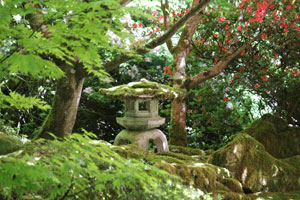
Lighting in a Japanese garden may be practical, but metal, stone and granite lanterns are mostly ornamental and often extremely beautiful, being originally used to illuminate pathways within ancient Buddhist temples and shrines.
While most outdoor spaces do have room for a lamp lit by a candle or an electric light, Japanese lanterns (toro) add an immediate oriental touch to any garden design, especially when paired with a maple or a pot of bamboo, immediately becoming a subtle focal point.

Different Styles
The choice of oriental lights available can be quite bewildering, not to mention extremely expensive due to being imported all the way from Japan. These range from hanging rusty Kaitomoshi shrine lamps and tall granite 'Kasuga' pillars, to short Maru Yukimi and Narabe Yukimi snow lanterns, and cantilevered Rankei lights hanging over water features.
Some lanterns stand on pedestals (Tachidoro) or a base with up to six curved legs (Yukimi-doro), while others have no base as such, with their post being buried deep in the ground for stability (Ikekomi-doro). Nozura-doro lanterns are much more rustic in design, being made from unpolished boulders and rocks, and often slightly cartoon-like in their appearance.
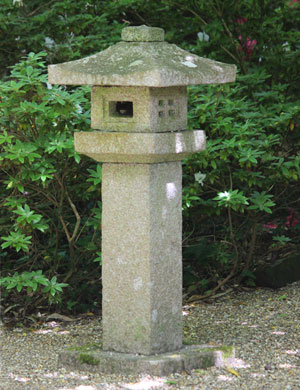
Cheaper Options
With a little bit of searching, there are some cheaper alternatives available, and you may even like to have a go at making your very own version. For a truly authentic appearance, hand-carved granite options are the number one choice, although lanterns made from concrete, resin, fibreglass or reconstituted stone, cast in a mould, can be extremely convincing, particularly once they have weathered and are beginning to attract a combination of moss and lichen.
Although many garden centres may sell their version of a Japanese lantern, these are generally worth avoiding, since they are often painted in reds and greens, or made with a yellow stone mix, rather like Bath stone or sandstone. However, it is worth bearing in mind that the bright appearance of a brand new stone lantern can be quickly softened and muted with a coat or two of extremely diluted black paint, which will quickly soak into the stone and turn it a more attractive grey.
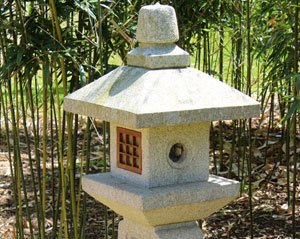
Historic Placement
Many of the granite lanterns that you see in traditional Japanese tea gardens are real works of art, resembling miniature temples, with tiny windows where the light of the candle can shine through.
In theory, these lights are placed alongside pathways, so that they can light the way in the dark, or next to a koi pond, to illuminate the rippling water and spotlight the big fish swimming past. For most landscaped oriental gardens, they are now purely decorative, although some are fitted with electric lights on a timer.
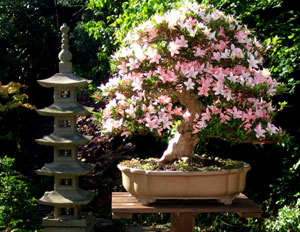
Granite Pagodas
A towering five-tier granite pagoda filled with twinkling tea lights can be quite a spectacle as the night draws in, with each of the tiers representing a different Buddhist element - earth, water, fire, air and spirit (moving upwards). However, whatever you decide to purchase or make, don't forget that less is always more.
It is important not to overdo things, with an occasional well-placed lantern being far more effective than a Japanese garden filled to the brim with granite lights.
Elements and Assembly
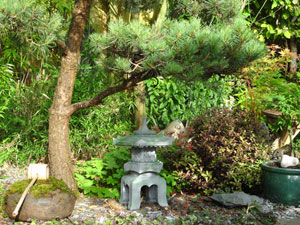
Stone and granite lanterns usually come in four or five separate parts, allowing them to be more easily transported and then assembled in the back garden.
The base should always be placed on firm, level ground, with a patio slab forming a suitable solid support and preventing the lantern from sinking into the soil or leaning to one side.
The 'fire box' element (Hibukuro) sits beneath the umbrella roof (Kasa), being usually topped by a finial or 'Hoju', which is often shaped rather like a pointed onion.
 Lighting in a Japanese garden may be practical, but metal, stone and granite lanterns are mostly ornamental and often extremely beautiful, being originally used to illuminate pathways within ancient Buddhist temples and shrines.
Lighting in a Japanese garden may be practical, but metal, stone and granite lanterns are mostly ornamental and often extremely beautiful, being originally used to illuminate pathways within ancient Buddhist temples and shrines.



 Stone and granite lanterns usually come in four or five separate parts, allowing them to be more easily transported and then assembled in the back garden.
Stone and granite lanterns usually come in four or five separate parts, allowing them to be more easily transported and then assembled in the back garden.